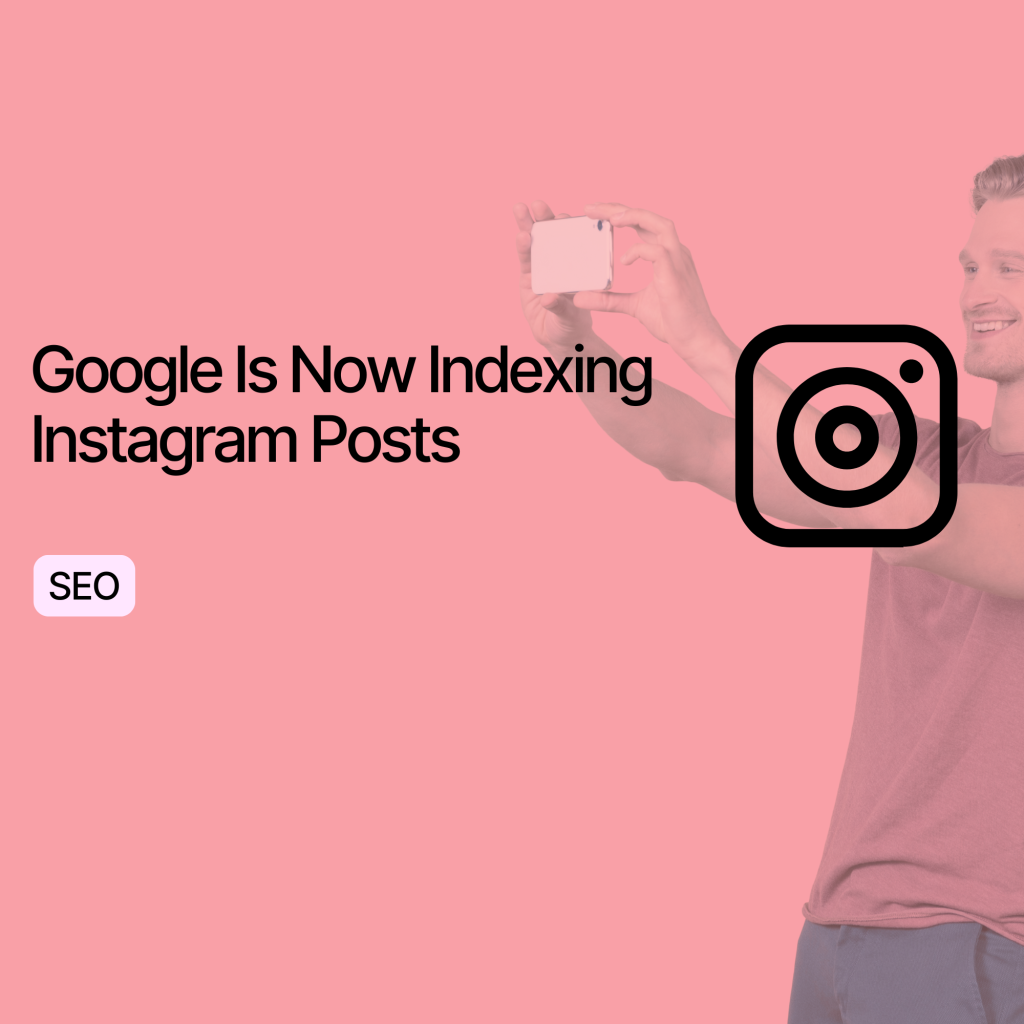On 10th July 2025, Google will officially begin indexing Instagram content from public professional accounts. In plain English: your Instagram posts, Reels, and videos from a business or creator account will start showing up in Google search results just like any other web content. This isn’t a minor tweak or rumour – it’s a confirmed update that blurs the line between social media and web search. For brands and creators, it means Instagram is no longer a walled garden; your social media content can become a discoverable asset on the wider internet.
What Is Changing on 10th July?
Instagram has historically kept its content mostly hidden from Google’s index. The platform even used robots.txt files and noindex tags to politely tell search engines “hands off”. Despite that, Google still managed to index millions of public Instagram posts (especially Reels and videos) over the years, while other search engines like Bing largely respected Instagram’s no-index requests.
The 10th July update changes everything: Instagram (via its parent, Meta) is allowing search engines to index all public content from professional accounts by default. A notification sent to users reads: “Your public photos and videos may soon appear in search engine results. From 10th July 2025, search engines will automatically be allowed to show all photos and videos on result pages.” In short, if you have a Business or Creator account that’s public (and you’re over 18), your Instagram posts and Reels are fair game for Google’s crawlers.
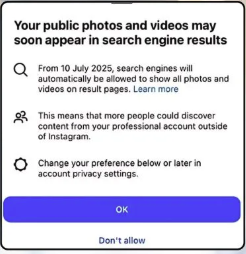
This means that when someone searches for a topic on Google, your Instagram content could appear alongside websites, news articles, or YouTube videos in the results. For example, a travel agency’s public Reel about “Bali sunset spots” might show up on Google when someone searches “best sunsets Uluwatu”, driving that searcher straight to the Instagram post. In essence, Instagram posts can act like mini web pages now, competing for visibility on Google.
Can you opt out? Yes. Instagram isn’t forcing anyone to be searchable. Professional account users will have a new privacy setting toggle to opt out of search engine indexing if they prefer to keep their content within Instagram. By default, though, indexing is on (for eligible accounts) after 10th July, meaning most businesses and creators will automatically get this broader exposure unless they disable it. Personal accounts (non-business) are unaffected – if you’re using a personal profile or your account is private, your content won’t be indexed by Google.
Why This Matters for Brands and SEO
This update is a game-changer for digital visibility. It represents the marriage of social media and search that marketers have anticipated for years. Here’s why it’s so important:
- A New Source of Organic Traffic: Up until now, your Instagram content’s reach was mostly limited to people on the app (followers, Explore page, etc.). With Google indexing, suddenly the whole web becomes your audience. People who don’t even use Instagram could discover your posts via a Google search. For small businesses and creators, this is a chance to get in front of new eyes without additional ad spend. Adding SEO thinking to your Instagram posts can take them beyond the Explore page and into Google search results.
- Social Content Competing in Search Results: Visual and short-form content can now directly compete with traditional web pages on Google. Google has been increasingly blending in videos and images for certain searches. Short videos and visuals might even outrank classic blog posts if they better satisfy the search intent. For example, someone searching “how to use window cleaner” might prefer a 30-second Instagram Reel demo over a text article. Google knows this, and with Instagram in the index, it can serve that Reel. This marks a shift toward multimodal SEO, where engaging visual content can be just as critical for search rankings as text content.
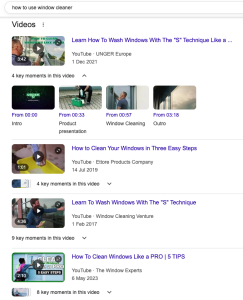
- TikTok & Others Set the Stage: Instagram’s move didn’t happen in isolation. Rival platforms showed the way. Since 2023, Google has been indexing TikTok videos – users love quick, visual answers. Instagram has an advantage now: it offers multiple content formats (photos, carousels, Reels) and has established business tools and trust with brands. If TikTok cracked open the door, Instagram is kicking it wide open – provided you take optimisation seriously.
- Search Behaviour Is Evolving: Especially among younger generations, social media itself has become a search engine for discovering products, restaurants, travel destinations, etc. (Think of how many times you’ve searched Instagram or TikTok for “NYC brunch spots” instead of Google!) Google indexing Instagram is partly a response to this trend, ensuring Google’s results include the rich social content people are looking for. For businesses, it means your Instagram content can play a role in the customer journey, even for those who start on Google. It also means your SEO strategy can’t ignore social content anymore – the walls between your website’s SEO and your social media presence are coming down.
- Instagram Already in Search: Even before this official change, Instagram content has been sneaking into Google results. A study in Italy found Instagram content appears in the top 10 Google results for over 669,000 keywords, and that over 600,000 Instagram Reels were already indexed by Google. Those numbers will explode higher once indexing is fully enabled. Instagram tends to rank around position 4 on Google on average when it’s relevant, meaning it often sits right on the first page. This suggests that for certain topics (think food, fashion, travel, entertainment), an optimised Instagram post can realistically claim a high-ranking spot on Google. The opportunity is real.
In short, social media and SEO are converging. Google’s recognition of Instagram content as “relevant content” signals that what you post on social media can be as important as what you post on your website in terms of online visibility. Brands that act fast can ride this wave and substantially increase their reach.
Optimising Your Instagram Posts for SEO
Getting indexed is step one – showing up and ranking well is step two. Now that your Instagram posts can surface on Google, you’ll want to optimise them similarly to how you’d optimise a webpage for search. Here are the key tactics to ensure your Instagram content is SEO-friendly:
- Use Keywords in Captions (and Even Your Bio): Treat your Instagram caption like a mini blog snippet. Identify what keywords people might search for that relate to your post, and naturally include those terms in your caption. For instance, if you’re posting a recipe, mention “easy vegan lasagna recipe” in the caption if that’s what it is, not just a bunch of emojis and inside jokes. Instagram captions can be longer if needed; don’t be afraid to write a descriptive, keyword-rich blurb. Also, ensure your profile bio contains your main keywords about who you are/what you do. Think: if someone searches Google, for instance a “wedding photographer in Cheshire”, will your Instagram bio make it clear you fit that description?
- Add Descriptive Alt Text to Images: Instagram allows you to add alt text for accessibility – use it! Write a concise description of your photo using relevant keywords. This alt text not only helps visually impaired users but also gives Google context about your image content. For example, alt text like “Photo of a red sports car at a local showroom event” is better than Instagram’s auto-generated alt like “Car and people”. Alt text can improve your chances of appearing in Google Images results as well.
- Strategic Use of Hashtags: Think of hashtags as meta keywords or tags for your content. They categorise your post and hint to algorithms what it’s about. While Google may not index the hashtag itself like a link, hashtags provide contextual relevance (and they still matter for Instagram’s search). Use a handful of highly relevant hashtags that match search themes. For example, a post about sustainable fashion might use #sustainablefashion #ecofriendlystyle, etc. This helps ensure you cover both Instagram’s internal search and the broader web context. Tip: Avoid overly generic or unrelated tags – focus on the quality, not just the quantity, of hashtags.
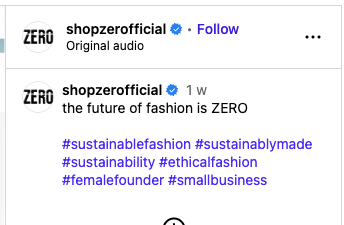
- Provide Real Value (Quality Content): This might sound generic, but it’s crucial. Google’s algorithms prioritise useful, high-quality content. So, an Instagram post that offers value or information is more likely to rank than one that’s purely self-promotional. Consider creating content that answers questions or provides tips, even in a visual format. For instance, a quick how-to carousel (“5 Steps to Perfect Latte Art”) or an infographic-style post can be both engaging on IG and useful from Google’s perspective. Think about user intent: What would someone be searching for that your post fulfils? Make your content as informative or inspiring as possible for that intent.
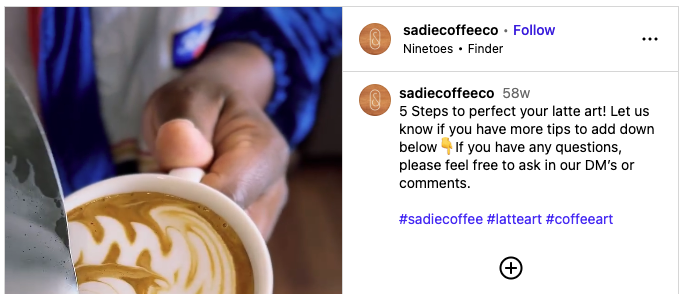
- Leverage Reels and Original Video Content: Instagram Reels (short videos) are hugely popular in-app, and now they may gain even more visibility via Google. If appropriate for your business, create Reels because Google is increasingly showing short videos in results. Include on-screen text or subtitles in your videos – not only does this cater to users who watch without sound, but it also means there’s text that Google could potentially read or use in understanding your video content. Originality counts too. Don’t just recycle content – put your spin or expertise into it so it stands out and gets rewarded by Google’s and Instagram’s algorithms, which both favour original content.
- Keep Technical Quality High: Ensure your images are clear (not pixelated) and your videos are of good quality. While Google won’t “rate” your photography skills, sharp images and good production value can indirectly affect user behaviour (nobody wants to click a blurry result). Moreover, file size and load speed matter – overly large images might load slowly, and user patience on mobile is short. Instagram handles compression, but it’s good practice to upload optimised images/videos so that anyone clicking through from Google has a smooth experience. Think of it this way: your Instagram profile is now like an extension of your website, so polish it up technically (fast load times, accessible content, etc.).
- Stay Relevant and Up-to-Date: Just as you’d update your website or blog with current content, keep your Instagram active with timely posts in your niche. Google loves fresh content for many queries. If you consistently post about trending topics or seasonal content relevant to your audience, those posts might catch Google’s eye. Plus, an active profile is likely to have more engagement, which could indirectly help (for example, a highly-engaged post might attract backlinks or mentions elsewhere).
In summary, optimise your Instagram content much like you do your website content. Use keywords thoughtfully, add descriptive text where possible, and create valuable, engaging posts. The goal is to make it easy for Google to understand what your post is about and recognise its value to searchers. Captions packed with in-jokes won’t cut it anymore. They need to carry your message and include the keywords that matter. In the new era, a clever one-liner caption won’t cut it if you want search visibility – combine your brand’s personality with some strategic SEO thinking.
Preparing for the Instagram SEO Era
The countdown is on – Google indexing of Instagram is here, and it opens up a big opportunity for those ready to seize it. If you’ve been treating Instagram as just social media, it’s time to also think of its potential as an SEO asset. Brands that adapt will enjoy a surge of new visibility, while those who ignore this change might find themselves playing catch-up later. A few final thoughts to keep in mind:
- Act Early: The update goes live on 10th July, but you should start optimising now. Posts old and new can appear in search, so update your profile and recent important posts with better captions or alt text if needed. Plenty of businesses will scramble after 10th July. The smart ones are already getting their content sorted. In other words, don’t wait until your competitor’s Instagram post outranks your website – get ahead of it.
- Monitor Your Results: Once indexing begins, keep an eye on whether your Instagram content is showing up in Google. Try inputting “site:instagram.com” into Google and searching for some keywords relevant to your recent posts. You might be surprised where you start to appear. Use Google Search Console (yes, you can verify your Instagram as a “website” via URL prefix property) to see if any Instagram URLs get impressions/clicks. This can give you insight into what content Google likes and what to create more of.
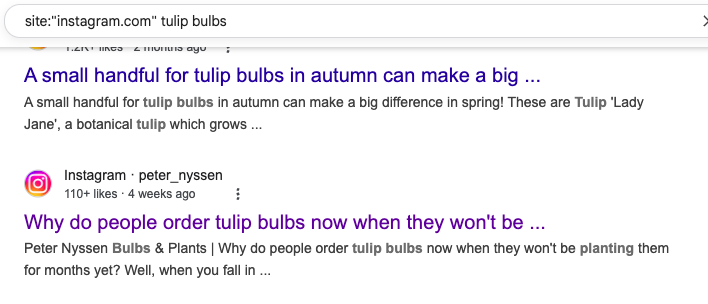
- Integrated Strategy: This change reinforces the importance of integrating SEO and social media strategies to work hand-in-hand. It’s all about your overall online presence. Now might be a great time to align your teams or efforts: your social media team and SEO team (if separate) should collaborate on keyword research, content themes, and cross-promotion. An Instagram post might inspire a blog article, and vice versa, creating a cohesive digital strategy that maximises your visibility everywhere.
Finally, remember that with greater reach comes greater responsibility. More eyes on your content means you should double-check that you’re proud of it and that it represents your brand well. People might first encounter you via a Google search that leads to your Instagram, so ensure your profile is polished and your posts tell your story effectively.
Need help making the most of this new Instagram SEO opportunity?
That’s where we come in. This update is exciting but can be overwhelming in practice, from keyword strategy for social posts to analysing what content resonates on search engines. Our SEO team are here to help you navigate this change. Whether it’s optimising your Instagram profile, crafting search-friendly posts, or developing a holistic content strategy, feel free to reach out to us. We’ve been tracking this Instagram-Google integration closely and can guide you so that your business rides this wave, rather than getting washed over by it.
In short, Google indexing Instagram posts is another aspect in the recent diversification of SEO. If you optimise and adapt, your Instagram can become a powerful funnel for organic traffic. So, get your content ready for visibility on search engines – and watch your reach grow!

